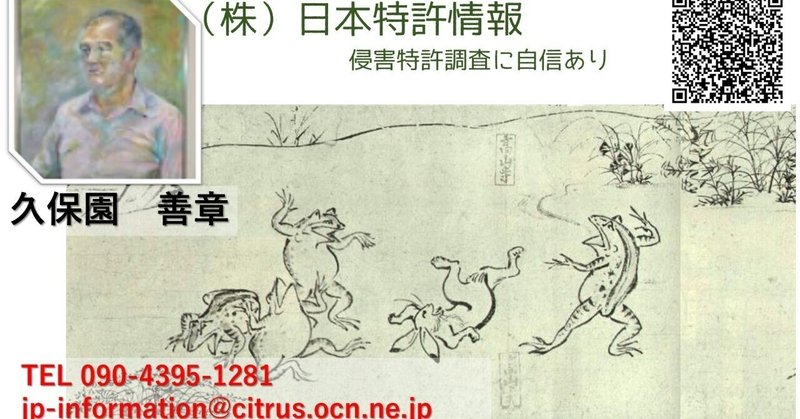
どうする特許庁! 目覚めよ審査官!! 「補正要件違反」で、お粗末な「審査」(サーチ)による特許付与を、です。
知的財産高等裁判所により、「補正要件違反」と断定され、「権利無効」とされたものの2件目です。
https://drive.google.com/file/d/1elLbg8Z1mnTzT9OkqZzXhVsQinWTu5tf/view?usp=drive_link
特許権者である原告の㈱タニタは、自分が保有する特許第3,830,255号(体内脂肪重量計)について、その特許の「有効性」を検証しなかったと思われます。
「有効性」とは、自社の特許についての、例えば「無効資料調査」等を行うことで、たとえ利害関係者などの第三者からの「無効審判」を起こされても、自社の特許は盤石であると確信することです。
それにも拘らず、特許庁より与えられた特許を有効と信じて、㈱オーワメディカルを特許侵害している、と提訴しました。
先ず、東京地方裁判所により、「本件特許は,同法123条1項1号に該当し,無効とされるべきものであり,原告は,同法104条の3により,同権利の行使をすることができない。」とされました。
その理由として「原告の請求は,補正制限違反を理由とする特許無効により,輸入自認物件については更に構成要件の非充足により,理由がないから,棄却することとし,主文のとおり判決する。」と述べています。
特許法123条1項1号は、新規事項追加(新規事項を追加する補正がされた場合)で、「補正要件違反」です。
そして、知的財産高等裁判所は、「本件製品1ないし8が本件特許権を侵害していると認めることはできず,控訴人の本訴請求はいずれも理由がなく,原判決は相当であって,本件控訴は理由がない。」との判断を下しました。
従って、本来なら、㈱タニタの出願に対して、特許庁は特許を与えるべきでなかったと考えます。
一方、特許庁での審査経過では、登録調査機関(IPCC)の検索者(佐藤茂)が作成した、幼稚でズサンな【検索論理式】を否として、審査官自らが【検索論理式】を作ったものと思われます。
これにより得られた引用文献をもって、「拒絶理由通知書」を発しましたが、出願人は「手続補正書」によりこれを回避し、結局、登録を勝ち取りました。
登録されたと言えども、裁判では上記の結果となりました。
繰り返しになりますが、登録調査機関の検索者が作成する【検索論理式】の無茶苦茶さ、そして特許庁の審査官による、不十分な「サーチ」に基づいての、特許付与は許されません。
特許庁の審査官は、所謂(サーチ)ではない、正しい「先行技術調査」を学び直す必要があると思います。
また、「行政」(特許庁)としては、「司法」(裁判所)により誤りを指摘されたことを謙虚に反省し、その誤りを正すことを心掛けるべきです。
ここで、本件特許公開の「出願情報」のうち「FI」と「Fターム」を、本エクセル資料の2シート目以降に挙げておきました。
( Google Translation )
What should the Patent Office do? Wake up Judge! !
The patent was granted due to poor "examination" (search) due to "violation of amendment requirements".
This is the second case in which the Intellectual Property High Court has determined that it is a violation of the amendment requirements and that the rights have been invalidated.
It is believed that the patentee, plaintiff Tanita Corporation, did not verify the "validity" of its patent No. 3,830,255 (Body Fat Scale).
"Validity" means that even if an "invalidation trial" is filed by a third party such as an interested party, the company's patent will remain valid by conducting, for example, "invalidation material investigation" regarding the company's patent.
It is to be convinced that it is rock solid. Despite this, we believed that the patent granted by the Patent Office was valid, and sued Owa Medical Co., Ltd. for patent infringement.
First, the Tokyo District Court ruled that "the patent in question falls under Article 123, Paragraph 1, Item 1 of the same law and should be invalidated, and the plaintiff will exercise the right according to Article 104-3 of the same law.
I can't do that.'' The reason for this is that ``The plaintiff's request is dismissed because the patent is invalid due to the violation of the amendment restriction, and because the constituent requirements for the admittedly imported product are not satisfied, so the plaintiff's request is dismissed as stated in the main sentence.'' says.
Article 123, Paragraph 1, Item 1 of the Patent Act is the addition of new matter (when an amendment is made to add a new matter), which is a violation of amendment requirements.
Then, the Intellectual Property High Court concluded, ``We cannot find that Products 1 to 8 infringe the Patent Right, and the appellant's claims in the main action are groundless, and the judgment in prior instance was reasonable. , the court ruled that there is no basis for this appeal.
Therefore, we believe that originally, the Japan Patent Office should not have granted a patent to Tanita Co., Ltd.'s application.
On the other hand, in the examination progress at the Patent Office, the examiner himself rejected the childish and sloppy [search logic formula] created by the registered search body (IPCC) searcher (Shigeru Sato).
I think it was made. A "notice of reasons for refusal" was issued with the cited document obtained as a result, but the applicant avoided this by submitting a "written amendment" and eventually won registration.
Even though it was registered, the above result was reached in court.
Once again, the granting of a patent based on the absurdity of the [search logical formula] created by the searcher of a registered search organization and the insufficient "search" by the patent office examiner is unacceptable. not.
I think examiners at the Patent Office need to relearn proper "prior art searches" rather than so-called (searches).
Furthermore, the ``administration'' (patent office) should humbly reflect on the fact that an error was pointed out by the ``judiciary'' (court) and strive to correct the error.
Here, the "FI" and "F-term" of the "application information" of the patent publication are listed in the second sheet and subsequent sheets of this Excel document.
(Google 翻译)
专利局应该做什么? 法官醒醒吧! !
通过对“违反修改要求”的不良“审查”(检索)授予专利。
这是知识产权高等法院判定其“违反纠正要求”并宣告权利无效的第二起案件。
据信,专利权人原告塔尼塔公司并未验证其第3,830,255号专利(体脂秤)的“有效性”。
“有效”是指即使利害关系人等第三方提出“无效审判”,通过对公司专利进行“无效宣告材料调查”等,该公司的专利仍然有效。
坚如磐石。
尽管如此,我们仍认为专利局授予的专利有效,并起诉大和医疗株式会社侵犯专利权。
首先,东京地方法院裁定:“涉案专利属于该法第123条第1款第1项规定的范围,应宣告无效,原告依据该法第104条之3的规定行使权利。
我做不到。
” 理由是“原告的请求以违反修改限制为由无效,而自行批准的条款进一步以不满足构成要求为由。
因此,原告的请求将被驳回,因为没有任何理由,将按照正文进行判断。”说。 专利法第一百二十三条第一项第一项为增加新事项(若修改增加新事项),属于“违反修改规定”。
知识产权高等法院表示,“我们不能接受产品1至8侵犯专利权,上诉人在本次诉讼中的主张均毫无根据,原判是适当的,这一上诉毫无根据。”
因此,笔者认为专利局不应该对谷田公司的申请授予专利权。
另一方面,在日本专利局的审查过程中,审查员拒绝了注册检索组织(IPCC)的检索员(佐藤茂)创建的幼稚且草率的[检索逻辑公式],并由审查员亲自编写了[搜索逻辑公式].大概是做出来的。
尽管使用通过此过程获得的引用文件发出了“驳回理由通知”,但申请人通过提交“书面修改”避免了这种情况,最终申请人获得了注册。
尽管已经注册,但试验却得出了上述结果。
再次强调,基于注册检索机构的检索员创建的[检索逻辑公式]的荒谬性以及专利局审查员的“检索”不充分而授予专利是不可接受的。
我认为专利局审查员需要重新学习正确的“现有技术检索”,而不是所谓的(检索)。
此外,“行政部门”(专利局)应该对“司法部门”(法院)指出的错误进行虚心反思,并努力纠正错误。
这里,该专利公开的“申请信息”的“FI”和“F项”列在该Excel文档的第二页和后续页中。
この記事が気に入ったらサポートをしてみませんか?
